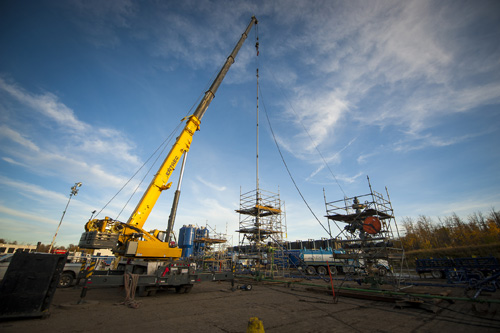20 April 2021–When hydraulic fracturing operations ground to a halt last spring in the Kiskatinaw area of British Columbia, researchers expected seismic quiescence in the region. Instead, hundreds of small earthquakes occurred for months after operations shut down, according to a new study.
In her presentation at the Seismological Society of America (SSA)’s 2021 Annual Meeting, Rebecca Salvage of the University of Calgary said about 65% of these events could not be attributed to either natural seismicity or active fluid injection from hydraulic fracturing operations.
Salvage and her colleagues instead suggest the latent earthquakes may be the result of aseismic slip, driven by fluid from previous hydraulic fracture injections keeping rock pore pressures elevated.
“Because there are lots of faults in that area, the fluid is becoming trapped in these zones,” Salvage explained. “And as aseismic deformation occurs, which leads to very, very slow slip in these zones, then you get seismicity generated from that process.”
The study by Salvage and her University of Calgary colleague David Eaton offers an unusual glimpse at how hydraulic fracturing may alter the rate of seismicity in a region long after active operations cease.
Their findings may reflect a new background rate of seismicity for the area, Salvage said, “but since this is such an unprecedented situation, we have no idea whether that is the case, and we won’t know until all hydraulic fracturing ceases in the Kiskatinaw Seismic Monitoring and Mitigation Area (KSMMA) entirely, which is unlikely to occur any time in the near future.”

Hydraulic fracturing operations are thought to be the main cause of seismic activity in the Kiskatinaw region, causing thousands of small earthquakes over the past two decades. The area, along with most of western Canada, has very few natural earthquakes. Between 1984 and 2008, before oil and gas operations in the area, seismologists detected only 20 earthquakes in the Kiskatinaw region, Salvage said.
Researchers had just finished installing a new seismic array in the KSMMA in January 2020, hoping to learn more about how active operations were related to earthquakes, particularly those of very small magnitudes.
Operators in the area have their own small private arrays, “but the public sensors in the area were much more scattered and sparse,” said Salvage. “We installed this array thinking, this is going to be great, we’re going to capture all this hydraulic fracturing.”
But when COVID-19 reached the region, operations came to a halt due to a government lockdown which caused plummeting oil and gas prices.
Then the researchers noticed things weren’t entirely quiet. Between April and August 2020, they detected 389 earthquakes during a period of almost no hydraulic fracturing. All of the earthquakes were magnitude 1.2 or smaller, “so it wouldn’t be noticeable to anybody that the background seismicity had increased without a seismologist doing the analysis,” Salvage said.
The earthquakes didn’t fall into the same patterns that would be expected of hydraulic fracturing-induced seismicity, according to the researchers. The rate of earthquakes persisted over time, instead of declining, and there was no pattern of earthquakes moving away from an initial source, as is often observed during active fluid injection.
Hydraulic fracturing has resumed in the area, along with an uptick in earthquakes, Salvage said.
